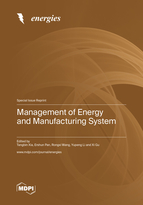Management of Energy and Manufacturing System
A special issue of Energies (ISSN 1996-1073). This special issue belongs to the section "F: Electrical Engineering".
Deadline for manuscript submissions: closed (30 August 2022) | Viewed by 17105
Special Issue Editors
Interests: energy management; sustainable manufacturing; energy saving of manufacturing system; operation & maintenance of power generation; prognostics & health management of power system
Special Issues, Collections and Topics in MDPI journals
Interests: quality and reliability engineering; prognostics and health management; production planning; lean management
Special Issues, Collections and Topics in MDPI journals
Interests: reliability and maintenance, quality control and performance condition evaluation of distributed and complex electromechanical system and the theory of complex network
Special Issues, Collections and Topics in MDPI journals
Interests: product evolution control and operation management of manufacturing and service systems
Special Issues, Collections and Topics in MDPI journals
Interests: smart manufacturing; reconfigurable manufacturing systems; production and maintenance decision-making; engineering education
Special Issues, Collections and Topics in MDPI journals
Special Issue Information
Dear Colleagues,
Meeting our current needs without sacrificing our ability to continue to do so in the future is a key sustainability concept which is increasingly becoming more challenging than ever, with the growing population rate,
As one of the experts in the field, you are cordially invited to submit your new papers to this Special Issue. We will publish your paper and will broadcast your brilliant ideas through communication media.
Detailed information regarding published articles, indexing, and editorial board members can be found at the journal website (https://www.mdpi.com/journal/energies).
The aims and scope include but are not limited to:
- Energy management;
- Green manufacturing;
- Sustainable manufacturing;
- Energy saving of manufacturing systems;
- Operation and maintenance of power generation;
- Prognostics and health management of power systems.
Dr. Tangbin Xia
Prof. Dr. Ershun Pan
Dr. Rongxi Wang
Dr. Yupeng Li
Dr. Xi Gu
Guest Editors
Manuscript Submission Information
Manuscripts should be submitted online at www.mdpi.com by registering and logging in to this website. Once you are registered, click here to go to the submission form. Manuscripts can be submitted until the deadline. All submissions that pass pre-check are peer-reviewed. Accepted papers will be published continuously in the journal (as soon as accepted) and will be listed together on the special issue website. Research articles, review articles as well as short communications are invited. For planned papers, a title and short abstract (about 100 words) can be sent to the Editorial Office for announcement on this website.
Submitted manuscripts should not have been published previously, nor be under consideration for publication elsewhere (except conference proceedings papers). All manuscripts are thoroughly refereed through a single-blind peer-review process. A guide for authors and other relevant information for submission of manuscripts is available on the Instructions for Authors page. Energies is an international peer-reviewed open access semimonthly journal published by MDPI.
Please visit the Instructions for Authors page before submitting a manuscript. The Article Processing Charge (APC) for publication in this open access journal is 2600 CHF (Swiss Francs). Submitted papers should be well formatted and use good English. Authors may use MDPI's English editing service prior to publication or during author revisions.
Keywords
- Energy management
- Green manufacturing
- Sustainable manufacturing
- Energy saving of manufacturing systems
- Operation and maintenance of power generation
- Prognostics and health management of power systems










